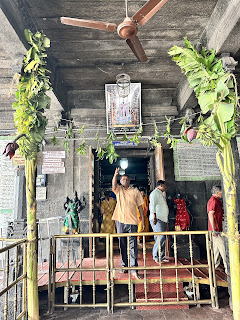Sue here. Its been a while since I’ve posted, mostly because Norm has done a great job of summarizing our activities, and partly because I finally succumbed to an unpleasant stomach bug that has diverted my attention elsewhere, in particular how to avoid throwing up when in transit from one location to another. This is probably the thing I was most nervous about before coming to India, but on the bright side, it has allowed me to explore some aspects of healthcare here! I am especially struck by the ease with which it is possible to purchase medications. There are pharmacies everywhere, and you literally tell the pharmacist the name of the drug you want, and they will mostly sell it to you without a prescription. Norm was able to purchase Ondansetron (an anti-sickness medication) and I was (inappropriately given my symptoms) offered Pantoprazole (a proto-pump inhibitor for reducing gastric acid) – both of which are only available on prescription in the US. For a cold, I was offered Azithromycin (an antibiotic – useless for colds). The other surprising thing is that medications are readily provided with few questions asked regarding symptoms and with no instructions for use, or information about side effects. On a positive note though, medications are MUCH cheaper than in the US.
So on Wednesday, at 5.30 in the morning, we started on the penultimate leg of our journey, catching an internal flight from Madurai to Chennai. We arrived with stomachs intact and immediately embarked on a whirlwind tour of the city. It took me a while to realize that Chennai used to be Madras – I was wondering why I hadn’t heard of it. We learned that the city had suffered badly in the Boxing Day tsunami of 2004, when about 8,000 people lost their lives across the state of Tamil Nadu. Another indication of the resilience of the Indian people is that there is little evidence of this disaster in the city.
Our visit began with a tour of the ubiquitous temple:
Norm was shouted at for taking a photo of the inner sanctum sanctorum – in fact he was going for the banana leaves …
We witnessed a wedding:
… then made a stop at St. Thomas Cathedral Basilica.
Built by the Portuguese in 1523, the cathedral is said to be built over the tomb of St Thomas the apostle (although our guide suggested that there is some controversy over whether Thomas ever came to the area). I think he did. There was a mass in progress during our visit and it was very moving. Next, we took a drive along the marine shore. Chennai has the second longest urban beach in the world at 12 kilometers. It is a very wide beach, and a hive of activity, with fisherman returning with their catch to be sold at the roadside – literally from the net. Just as well, as there is no evidence of refrigeration in the 30C heat.

Then on to Fort St. George, the first English fortress built in India in 1639 by the East India Trading Company. Since there was nothing here except a few fishing villages when they built it, it is generally claimed that the city developed around the fortress. The fort is now the headquarters for the legislative assembly of Tamil Nadu state and is a lively place, with areas preserved for historical purposes and a museum. We particularly appreciated the peace and stillness of St Mary’s church – the oldest Anglican church in India, completed in 1680.
Inside, the church is very much in the traditional Anglican style and we could have been in an English country church. Here we found numerous memorials to very young solders, including one Thomas Davies, who died in a clash with sepoy infantry at the age of 21.
Our tour concluded with a visit to a gallery of bronze sculptures, and I am finally getting my head around the distinctions between the different manifestations of the Hindu god. I now know that Brahma, Vishnu and Shiva are the three main ones, but apparently there are 330 million altogether! Now, I wish we had paid the extra fee to take photographs, as the sculptures were magnificent. If you are interested in seeing some, Google ‘bronze gallery Chennai’ and click on the photos.
One other thing I have been meaning to comment on is the style of dress here, particularly in the South. I have been surprised that the majority of women, in the markets for example, have been wearing saris rather than Western dress. These are generally made of cheaper materials (cotton, nylon), but are incredibly colorful and vibrant. Made me realize how drab we can be in the West (or maybe how drab I am!).
We have one more day to report before the gruelling 40+ hour trip back to Rochester. It’s been amazing.






















































